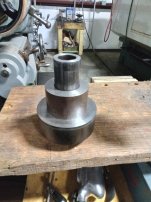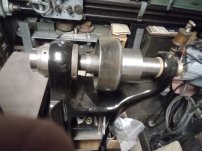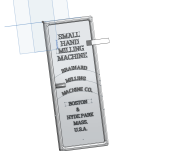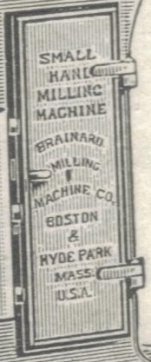M.B. Naegle
Diamond
- Joined
- Feb 7, 2011
- Location
- Conroe, TX USA
More thoughts on the age of this mill:
Looking online, very little remains of pre-Becker Brainard machines. Vintage Machinery has the most information in one place (Brainard Milling Machine Co. - History | VintageMachinery.org) but from there I've been looking to see what other machines are still out there from the 1871-1899 era. In general, anything pre-1871 would have been when Amos Brainard was still under Union Vise's roof (and it seems that he was only with them since 1865), and anything after 1899 would have been after Becker bought the company. Becker-Brainard's have showed up from time to time online, but not much from when it was "just" Brainard.
Brainard horizontal milling machine co.
This 2016 thread shows what seems to be a much earlier Brainard. Note that the base and frame casting are much different. I imagine this might even be the shop-made design that Amos Brainard developed at Union Vise, because here:
Patent Images
We see a 1887 patent showing the base/frame design that my Small Hand Mill and later Becker-type mills were modeled after. 1887-1899 isn't a huge window, but I'm a little more certain that that's where my mill falls.
Determining the exact age of the machine might be of little consequence, if at all possible, but putting a little more identity to the machine has merit I think. Often we have so little of the legitimate history of our machines in who owned them and what they made, that just knowing how the machine began life is all you can do. I think the historical aspect of machines like this is also fascinating in seeing what the world was like when the machine was built and later through the years. How the machine influenced the world and how the world influenced the machine.
Often the age of these machines takes me by surprise. Not so much how 'long' ago it was... but how NOT long ago! Our family business goes back as far as 1858, and the other day I found a sales receipt for our company from 1901 addressed to a company in Oklahoma TERITORY. It's interesting to think that there really wasn't that much time between "cowboys and Indians," and world wars. Every time I stand in front of my 1909 Hendey, I marvel that when it was new, the idea of a "World War" was still futuristic, and the Titanic hadn't even sailed.
The industrial revolution was active for awhile, but looking at catalogs and remaining machines it seems that there was a serious surge in technology around the 1880-1900 era. Lots of iron was cast then that was obsolete and replaced by the first world war. Same happened when the second world war happened and then the cold war. Sometimes seeing how these machines fit into those eras gives a lot of perspective as to how far they/we have come, or how little has changed.
I'm still young, but the older I get the more I find that "history" is much closer than you think and it's prudent to be comfortable with it while also knowing that the future is constantly changing and intangible. It seems all to often people see it the other way around: the past no longer exists and the future is now.
Looking online, very little remains of pre-Becker Brainard machines. Vintage Machinery has the most information in one place (Brainard Milling Machine Co. - History | VintageMachinery.org) but from there I've been looking to see what other machines are still out there from the 1871-1899 era. In general, anything pre-1871 would have been when Amos Brainard was still under Union Vise's roof (and it seems that he was only with them since 1865), and anything after 1899 would have been after Becker bought the company. Becker-Brainard's have showed up from time to time online, but not much from when it was "just" Brainard.
Brainard horizontal milling machine co.
This 2016 thread shows what seems to be a much earlier Brainard. Note that the base and frame casting are much different. I imagine this might even be the shop-made design that Amos Brainard developed at Union Vise, because here:
Patent Images
We see a 1887 patent showing the base/frame design that my Small Hand Mill and later Becker-type mills were modeled after. 1887-1899 isn't a huge window, but I'm a little more certain that that's where my mill falls.
Determining the exact age of the machine might be of little consequence, if at all possible, but putting a little more identity to the machine has merit I think. Often we have so little of the legitimate history of our machines in who owned them and what they made, that just knowing how the machine began life is all you can do. I think the historical aspect of machines like this is also fascinating in seeing what the world was like when the machine was built and later through the years. How the machine influenced the world and how the world influenced the machine.
Often the age of these machines takes me by surprise. Not so much how 'long' ago it was... but how NOT long ago! Our family business goes back as far as 1858, and the other day I found a sales receipt for our company from 1901 addressed to a company in Oklahoma TERITORY. It's interesting to think that there really wasn't that much time between "cowboys and Indians," and world wars. Every time I stand in front of my 1909 Hendey, I marvel that when it was new, the idea of a "World War" was still futuristic, and the Titanic hadn't even sailed.
The industrial revolution was active for awhile, but looking at catalogs and remaining machines it seems that there was a serious surge in technology around the 1880-1900 era. Lots of iron was cast then that was obsolete and replaced by the first world war. Same happened when the second world war happened and then the cold war. Sometimes seeing how these machines fit into those eras gives a lot of perspective as to how far they/we have come, or how little has changed.
I'm still young, but the older I get the more I find that "history" is much closer than you think and it's prudent to be comfortable with it while also knowing that the future is constantly changing and intangible. It seems all to often people see it the other way around: the past no longer exists and the future is now.















